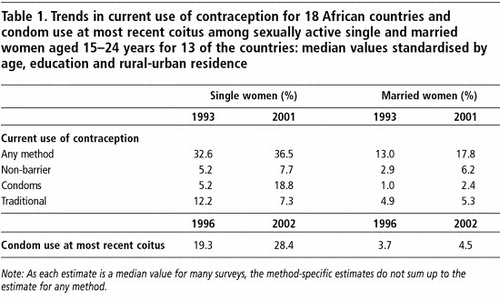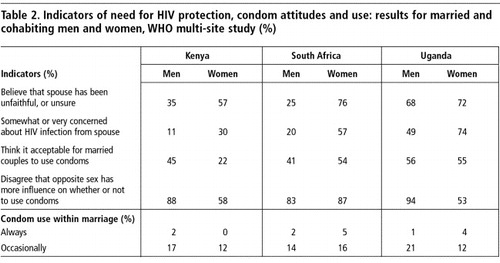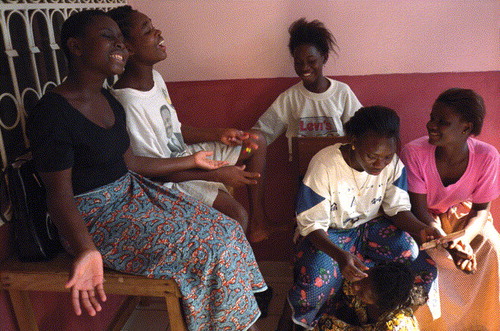Abstract
The trends in contraceptive uptake and condom use among single and married young women show distinct patterns in sub-Saharan Africa. A large median increase of 1.4 percentage points per year in condom use by single young women for pregnancy prevention was witnessed in 18 countries based on Demographic and Health Survey data from 1993 to 2001. In contrast, a modest increase in condom use was noted for married or cohabiting young women. Condom promotion in Africa has been, therefore, a success for single women. Its promotion for pregnancy prevention offers even greater potential, as pregnancy prevention is the main or partial motive of most single women who use condoms. While a myriad of research studies on condom use among young single people have been conducted and published, the needs of the married and cohabiting population have been neglected by researchers and programme staff alike, despite the fact that more than half of HIV infections in the severe epidemics of Southern and East Africa are occurring in this group. The barriers to condom adoption by married couples may not be as severe as is often assumed.
Résumé
Les tendances dans la prise de contraceptifs et l’utilisation de préservatifs chez les jeunes femmes célibataires et mariées présentent des caractéristiques distinctes en Afrique subsaharienne. De 1993 à 2001, les enquêtes démographiques et sanitaires de 18 pays ont révélé une forte croissance médiane de 1,4 point par année de l’utilisation de préservatifs chez les jeunes femmes célibataires souhaitant éviter une grossesse. Par contre, chez les jeunes femmes mariées ou en cohabitation, cette augmentation a été modeste. La promotion des préservatifs en Afrique a donc été un succès chez les femmes célibataires. Leur promotion pour la prévention des grossesses présente un potentiel encore plus grand, puisque le motif principal ou partiel de la plupart des femmes célibataires utilisant des préservatifs est d’éviter une grossesse. Alors qu’une multitude d’études ont été publiées sur l’emploi des préservatifs chez les jeunes célibataires, les besoins des couples mariés ou qui cohabitent ont été négligés aussi bien par les chercheurs que par le personnel des programmes, alors que plus de la moitié des infections à VIH dans les graves épidémies d’Afrique australe et orientale se produisent dans ce groupe. Les obstacles à l’adoption de préservatifs par les couples mariés ne sont peut-être pas aussi insurmontables qu’on ne le suppose souvent.
Resumen
Las tendencias en la aceptación de anticonceptivos y en el uso del condón entre las mujeres jóvenes, tanto solteras como casadas, muestran patrones marcados en Africa subsahariana. Con base a los datos de la Encuesta de Demografía y Salud realizada desde 1993 hasta 2001 en 18 países, se presenció un gran aumento promedio del 1.4 por ciento al año en el uso del condón por las mujeres jóvenes para evitar el embarazo. En cambio, entre las casadas o entre las jóvenes en cohabitación, se observó un pequeño aumento. Por tanto, la promoción del condón en Africa ha tenido éxito entre las mujeres solteras. Su promoción para la prevención del embarazo ofrece aun más potencial, dado que éste es el motivo principal o parcial de la mayoría de las mujeres solteras que usan condones. Aunque se han realizado y publicado diversos estudios de investigación sobre el uso del condón entre la gente joven soltera, las necesidades de la población casada y en cohabitación han sido descuidadas tanto por los investigadores como por el personal de programas, pese al hecho de que este grupo presenta más de la mitad de las infecciones por VIH en las graves epidemias de Africa meridional y oriental. Las barreras a la adopción del condón por parte de las parejas casadas posiblemente no sean tan grandes como suele suponerse.
The main purpose of this paper is to present a concise summary of trends in protective behaviour among single and married women in sub-Saharan Africa aged 15–24 years. Equal emphasis is placed on protection against unintended pregnancy and against sexually transmitted infections, including HIV. The paper supplements evidence from recent publications with new analyses. The paper also considers prospects for greater uptake of condoms among married or cohabiting couples in East and Southern Africa.
Abstinence among single women
For tracking of behavioural trends, the Demographic and Health Surveys (DHS) have emerged as the premier source of reliable information because of their adherence to high standards of survey execution and standardised instruments. Eighteen countries in sub-Saharan Africa, representing over half of the sub-region’s total population, have conducted two or more such surveys. The countries are equally split between East and Southern Africa, with severe HIV epidemics, and West and Central Africa, with less severe epidemics. With this geographic coverage, it is reasonable to generalise from the results of these surveys to the whole sub-region. Using these data, Cleland and Ali have shown that the proportion of single women who had not had sexual intercourse changed little between 1993, the median date of the earlier survey and 2001, the date of the most recent survey.Citation1 Among all 18 countries, the median per cent of single women reporting no sexual intercourse was unchanged at about 60%. Wide variations between countries were recorded, however, from 90% in Rwanda to 39% in Namibia, which serve to underscore the well-known but often overlooked fact that the region is immensely varied in terms of sexual culture.Citation2 Thus, the promotion of sexual abstinence until marriage may resonate in some settings but prove to be counter-productive in others.
Secondary abstinence, defined as no intercourse in the three months preceding the survey, among single women who had had intercourse at least once, was also examined as a possible indicator of more cautious selection of partners and/or reduced coital frequency with partners. Again, few differences were found between 1993 and 2001. The median percentage for all 18 countries rose slightly from 44% to 49% but changes in most countries were not statistically significant. These results, however, indicate that, for many single women, intercourse is a rare event, a feature that has great relevance for contraceptive method choice, as will be shown below.
Contraceptive method use among single and married women
Table 1 shows trends in current contraceptive use for women who reported intercourse in the previous three months. Among single women, a slight overall increase occurred in use of any method, from 33% in 1993 to 36.5% in 2001. Use of non-barrier methods (mainly pills) was very low and essentially unchanged, a reflection perhaps of barriers to access or unwarranted fears that hormonal methods may jeopardise future childbearing.Citation3Citation4 Use of traditional methods, mainly periodic abstinence, fell, a trend to be welcomed, as most young women have incorrect knowledge about the safe period.Citation5 The most striking feature for single women, as evident in Table 1, is the large increase in condom use for pregnancy prevention, up from 5% in 1993 to 19% in 2001. The trend was statistically significant in 13 of the 18 countries and the average annual rate of increase was 1.4 percentage points per year, or 14 percentage points over the decade. This pace of change is strikingly similar to the increase in overall contraceptive use among married women in developing countries over recent decades. In most countries over 80% of single women reported that condoms were obtained from shops or pharmacies.
The results for young married women contrast sharply with those for single women. Contraceptive use was much lower and had changed rather little. Use of non-barrier methods rose slightly, from a median of 3% in 1993 to 6% in 2001. Condom use remained very low, at 2.4%, even in 2001. The only countries where condoms were used for family planning by 5% or more of young married women in the most recent survey were Cameroon (12%), Zambia (6%) and Namibia and Tanzania at 5%.
Condom use at most recent coitus: single vs. married women
For 13 out of the 18 countries, information from two or more DHSs is available on condom use at most recent coitus. The relevant question is posed at a later stage of the interview from questions on contraceptive use and makes no mention of the motive for use. Thus answers to this question should capture condom use motivated by disease prevention in addition to use motivated by pregnancy prevention. The median dates of the earlier and most recent surveys are 1996 and 2002. The results are shown in the bottom row of Table 1. Once again, a sharp distinction is apparent between the behaviour of young single and young married women. Between 1996 and 2002, the percentage of single women reporting condom use at last coitus rose from 19.3% to 28.4%, equivalent to an average annual increase of 2.1 percentage points, whereas the parallel increase for married women was negligible: 3.7% to 4.5%.
Condom use for contraception versus disease prevention among single women
The fact that information on condom use in the DHS is elicited at two separate points in the interview permits an insight into the relative importance of the two motives for use of this method. Specifically, the contraceptive status of women who reported condom use at most recent coitus is revealing. The median results from the most recent survey for the 13 countries where both types of information were available show that 59% of those using condoms at last coitus had earlier in the interview reported current use of this method for family planning, 7% reported current use of a non-barrier method of contraception; 4% used periodic abstinence or withdrawal while the rest had reported no current contraceptive use. Because motives for condom use are undoubtedly complex and also influenced by the sexual partner, interpretation must be cautious but this pattern suggests that pregnancy prevention was the main or partial motive for about 60% of all single, female condom users and that double-method protection was rare.
Research focused on married or cohabiting couples
Studies on condom use among young single people have been numerous. However, the needs of the married population have been neglected by researchers and programme staff alike, despite the fact that more than half of HIV infections in the severe epidemics of Southern and East Africa occur in this group.Citation6 The main exceptions are a small intervention in Zimbabwe,Citation7 studies of the behaviour of HIV discordant couples in Zambia,Citation8 an exploratory study in Uganda,Citation9 and a World Health Organization (WHO)-sponsored study in six African countries.Citation10Citation11 The WHO results are of great potential importance because they challenge the prevailing view that greater condom uptake by couples in long-term relationships is a hopeless aim because of intractable resistance and that wives are powerless to protect themselves in the face of adamant opposition from husbands.
Concern about marital HIV infection is clearly evident in Table 2, which shows key results for three of the six countries that participated in the WHO study. In two of the three countries, a majority of wives were “somewhat or very concerned” and this feeling no doubt stems from fears about husbands’ infidelity. In Kenya and South Africa, husbands were less concerned than wives about spousal fidelity and infection but in Uganda the difference between the sexes was narrower. Attitudes towards condom use are particularly revealing. In Kenya, husbands were more positive than wives; in Uganda, attitudes of husbands and wives were almost identical; only in South Africa were wives more likely to think it acceptable to use condoms within marriage. In all three sites, over 80% of husbands disagreed with the proposition that women had more influence than men on condom use decisions. This result is consistent with conventional wisdom. The views of wives themselves were more surprising, however. Over half of wives in Kenya and Uganda and a larger majority in South Africa refuted the view that men wielded more influence. A more detailed multivariate analysis of the WHO data set found that condom attitudes and fear of HIV infection of husbands and wives were equally related to the probabilities of condom use.Citation11 This suggests that the influence of husbands and wives on condom use was approximately equal. Similarly, an in-depth analysis of the South Africa data showed that the wife’s fear of HIV infection was the most powerful predictor of condom use.Citation12 With regard to the level of condom use among married couples, the WHO study confirms DHS results that consistent use is very low. Occasional use, however, was reported by 10–21% of both husbands and wives in the three national settings. Though the term “occasional” is vague, this finding suggests that the incorporation of condoms into marriage is by no means impossible.
The qualitative approach adopted in the Uganda study complements the WHO study by providing further insight into factors that facilitate condom adoption in marriage.Citation9 It was found that women usually initiated discussion about condoms and had been encouraged to do so by health staff or prompted by the results of an HIV test. Some women were assertive with their husbands and refused sex without a condom. Others used more gentle methods of persuasion. About half the women classified as consistent users reported little or no resistance from their male partner.
Condom use for family planning among married young women
One of the most important findings from the Uganda study is evidence of the successful deployment by wives of family planning as the justification for condom use, thereby circumventing the need for accusations – implied or explicit – of infidelity or infection. Use of non-barrier methods of contraception is low in Uganda and thus more women may be able to use this argument convincingly than in countries where use of injectables and pills is much higher. The WHO study showed that, in Uganda, the majority of consistent or occasional users were using no other contraceptive method. Conversely, in Kenya and South Africa, the majority of married condom users were also using a non-barrier method of contraception. One plausible interpretation is that women are reluctant to forego the contraceptive confidence of hormonal methods for the condom that has a higher failure rate and, for which, consistent use is so difficult to achieve.
Discussion
Two crucially important policy and programme lessons may be drawn from this brief review. First, condom promotion in Africa has been a success for single women and social marketing can take much of the credit. What is required now is continued financial support for this activity. It is a public health scandal that US President’s Emergency Plan for AIDS Relief (PEPFAR) funds cannot be used for active condom promotion to youth and the married population. Other donors should be prepared to step in and play a more active role. The fact that pregnancy prevention is a major motive for condom use by single women needs to be noted. Greater impact may be achieved if marketing campaigns positioned condoms as a means of pregnancy, rather than disease, prevention.
The second lesson is that the needs of married and cohabiting couples for protection should not continue to be ignored as a hopeless cause. The stereotyping of husbands as irresponsible brutes who have no concern for their wives’ (or their own) protection against HIV has been deeply damaging. The evidence presented in this paper is more balanced and positive and, we believe, closer to the truth. Condoms are beginning to permeate into marriage in East and Southern Africa and this trend needs to be supported in every possible way. The increase in the uptake of voluntary testing and counselling has been slow, but could rapidly grow if barriers such as stigma, lack of access to treatment or to testing services are overcome. An increase in voluntary testing would yield many more HIV-discordant couples, thus reinforcing the need for greater condom use in stable partnerships.
Acknowledgements
The views expressed are those of the authors and do not necessarily reflect those of their organisations. An earlier version of this paper was presented at Condoms: An International Workshop, 21-23 June 2006, London.
References
- Cleland J, Ali MM. Sexual abstinence, contraception and condoms: trends in young single African women, 1993–2001. Lancet (in press).
- C Bledsoe, G Pison. Nuptiality in Sub-Saharan Africa: Contemporary Anthropology and Demographic Perspectives. 1994; Clarendon Press: Oxford.
- K Wood, R Jewkes. Blood blockages and scolding nurses: barriers to adolescent contraceptive use in South Africa. Reproductive Health Matters. 14(27): 2006; 109–118.
- S Castle. Factors influencing young Malians’ reluctance to use hormonal contraceptives. Studies in Family Planning. 34(3): 2003; 186–199.
- Y Che, JG Cleland, MM Ali. Periodic abstinence in developing countries: an assessment of failure rates and consequences. Contraception. 69: 2004; 15–21.
- S Hugonnet, F Mosha, J Todd. Incidence of HIV infection in stable sexual partnerships: a retrospective cohort study of 1802 couples in Mwanza Region, Tanzania. Journal of AIDS. 30: 2002; 73–80.
- A O’Leary, J Moore, E Khumalo-Sakutukwa. Association of negotiating strategies with consistent use of male condoms by women receiving an HIV prevention intervention in Zimbabwe. AIDS. 17: 2003; 1705–1706.
- S Allen, J Meinzen-Derr, M Kautzman. Sexual behaviour of HIV discordant couples after HIV counselling and testing. AIDS. 17: 2003; 733–740.
- NE Williamson, J Liku. Breaking the ice: introducing condoms into primary relationships in Uganda. Reproductive Health Matters. 14(28): 2006; 89–98.
- Pullum T, Cleland J, Shah I. Factors affecting condom use in primary sexual relationships in sub-Saharan Africa. Paper presented at Annual Meeting of the Population Association of America, Boston, April 2004.
- Pullum T, Cleland J, Shah I. Consensus, power and trust in the use of family planning and condoms by couples in Eastern and Southern Africa. Paper presented at XXV International Conference of the IUSSP, Session 124, Tours, 18–23 July 2005.
- P Maharaj, J Cleland. Risk perception and condom use among married or cohabiting couples in KwaZulu-Natal, South Africa. International Family Planning Perspectives. 31: 2005; 24–29.


